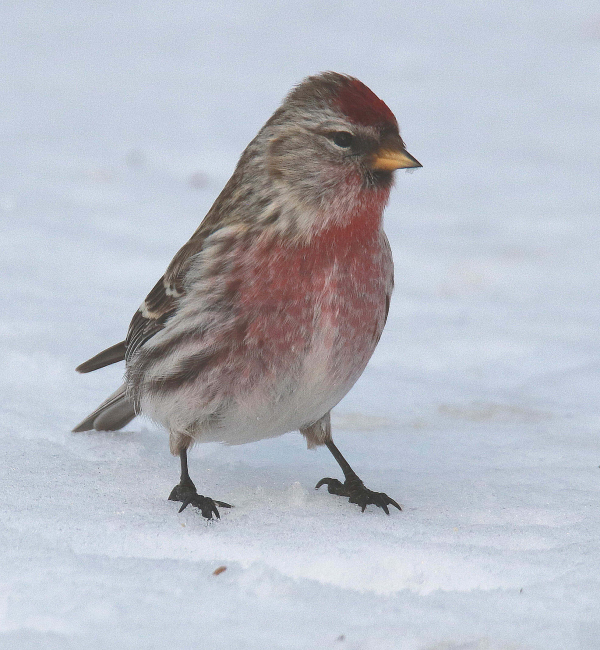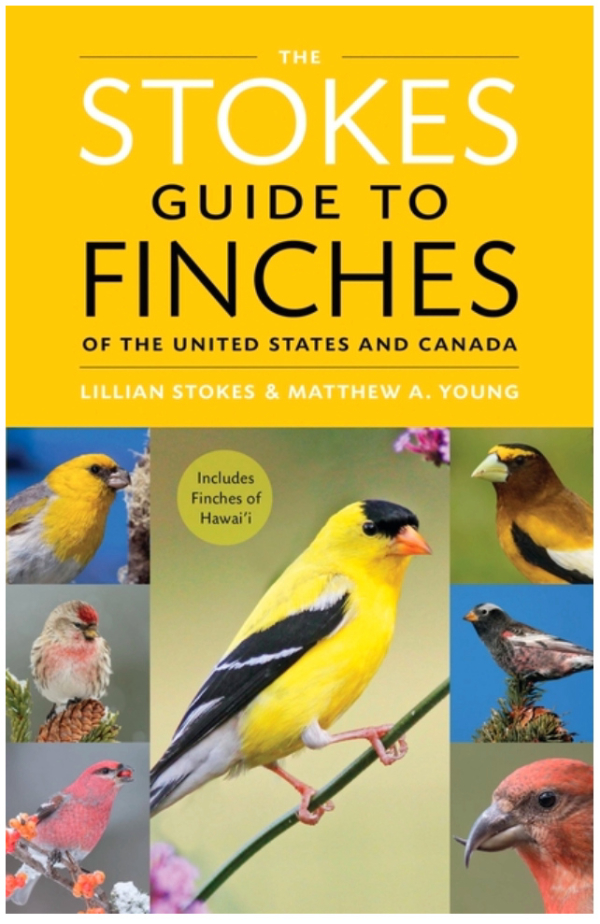
The Finch Forecast provides an annual look into the potential for movements south by some favorite winter feeder visitors (Redpoll photo by Paul Konrad).

It’s always a thrill to have northern finches arrive in your area to visit your feeders (Evening Grosbeaks photographed by Paul Konrad).

The highly recommended new book, “The Stokes Guide to Finches” is available Now!
|
The highly anticipated 26th Annual Winter Finch Forecast was published last week by Tyler Hoar and the Finch Network, a report that gives us insights into what species may be visiting your feeders from the northern forests of Canada and Alaska, or from higher mountain elevations. Finches studied include Pine Grosbeaks, Evening Grosbeaks, Purple Finches, Redpolls, Pine Siskins, Red Crossbills, and White-winged Crossbills, along with 3 non-finch species that typically fly south in search of fall and winter food in large numbers – Red-breasted Nuthatches, Blue Jays, and Bohemian Waxwings.
Individual Species Information:
Pine Grosbeaks – Most Pine Grosbeaks should remain in the boreal forest with some movements into their traditional wintering areas in western and southeast Canada and northern New England states as wild food sources to the north are consumed. Areas around Lake Superior, particularly northern Minnesota, should see a larger movement as the weaker pinecone seed crop in northwest Ontario is consumed. Roaming Pine Grosbeaks will search for fruiting ornamental trees like mountain ash and crab apples, plus well-stocked feeders with black oil sunflower seeds.
Evening Grosbeaks – There should be a moderate flight of Evening Grosbeaks southward this fall. Evening Grosbeaks should visit areas from the Maritime provinces south toward Pennsylvania. Areas even further south to the mid-Atlantic states may see Evening Grosbeaks this winter too. With the alternate food source of spruce budworms becoming more widespread and scattered around Lake Superior, western Great Lakes states may see even more movements of this species during winter. Evening Grosbeaks from northwest Ontario westward should move out of the boreal forest, looking for feeders in towns or suitable food sources further south.
Purple Finches – A visible movement of Purple Finches has already been moving south out of Canada, as reported by the Hawk Ridge HawkWatch near Duluth, Minnesota, and by sources in central New York. This year the majority of Purple Finches should leave Canada with a likely moderate flight into the Great Plains and southern United States. Small numbers are anticipated to remain in Canada from southern Ontario east to the Maritime provinces.
Pine Siskins – Many Pine Siskins will remain in the boreal forest and western mountains this winter, but areas from Manitoba eastward that were affected by spruce budworm infestations have a poor cone crop, so Pine Siskins that nested there will be on the move. Band recoveries indicate Pine Siskins will move south across North America from coast to coast, so there should be some small movements south in the eastern half of the United States this fall in search of food.
Redpolls – The boreal forest appears to have a widespread average birch seed crop this winter, although some areas that were not affected by tent caterpillars in northeast Ontario and Quebec have abundant birch seed crops. Areas south of the boreal forest from Lake Huron east into New England appear to have scattered areas of good white birch and yellow birch seed crops, and the alder seed crop across the boreal forest appears to be above average. Beyond the forests, Redpolls prefer foraging in weedy fields, and if snow doesn’t cover these fields there should be ample food to keep most Redpolls north. Areas in the upper Midwest states and the Maritime provinces may see more Redpoll movement as southbound birds transit areas with poor cone seed production. (Earlier this year, the 3 redpoll species – Common Redpoll, Hoary Redpoll, and Lesser Redpoll – were “lumped” into a single species named Redpoll, because genetic research revealed a supergene was responsible for the Redpoll plumage differences rather than species differentiation.)
White-winged Crossbills – With a good white spruce seed crop across most of the boreal forest and good multi-species cone crops in the western mountains, most White-winged Crossbills should remain in the boreal forest. Some White-wings will move out of this region throughout the winter and in areas of poor cone crops, ornamental spruces in urban areas laden with cones attract crossbills. In areas where significant winter storms and freezing rain events occur, it can cause flocks of White-winged Crossbills to quickly leave to search for accessible food. Watch for crossbills and other finches in neighboring areas, primarily to the south, after these weather events.
Red Crossbills – Most of last year’s invasion of western-type Red Crossbills appear to have returned west over the summer. Currently, Red Crossbills are common in the Adirondacks east into Nova Scotia, feeding on the red spruce seed crop. There are more modest numbers from Algonquin Provincial Park to the upper Great Lakes states, and Red Crossbills will likely be scattered in very small numbers across their winter range.
Red-breasted Nuthatches – A great balsam fir seed crop is widespread in some areas but completely absent in other areas across the boreal forest. As a result, a moderate flight of Red-breasted Nuthatches is expected, with a few birds already being noted as far south as the Gulf Coast.
Bohemian Waxwings – Most Bohemian Waxwings will likely stay in the north because native mountain ash berry crops and other berries are good across much of the boreal forest.
With poorer berry crops in northwest Ontario, northern Midwest states may see more widespread movements of Bohemian Waxwings. Small numbers will probably arrive mid-winter to late winter in traditional areas from central Ontario east into the Maritime provinces, New England, and northern New York as winter progresses and food resources are reduced. Bohemian Waxwings on the move south will forage on buckthorn and planted mountain ash berries and crab apples.
Blue Jays – In eastern North America west to Manitoba the deciduous tree seed crop, which includes acorns, appears below average with scattered areas of average production, so expect a moderate to strong flight south this fall.
How can you “set the table” for these exciting feeder visitors? It’s simply a matter of providing “the best bird seeds” – black oil sunflower seeds. That’s not to say you will attract these birds by providing this primo food source, but it gives you the best chance of attracting them should they arrive in your area this fall or winter.
The above Finch Forecast information is provided by Tyler Hoar and is based on field reporters’ information that this year there is a widespread conifer cone crop from northern British Columbia to eastern Quebec and down the western mountain ranges. However, some areas have been impacted across significant areas by forest fires, insect infestations (spruce budworms, tent caterpillars, etc), and drought. For example, northwest Ontario northwest of Lake Superior is one area with poor pine cone seed production.
This year’s pine cone crop across the boreal forest was primarily driven by 2 significant finch food sources, seeds from white spruce and tamarack trees, with white birch and balsam fir seeds also contributing to the overall food sources available for finch populations. Also, to quote one of the cone crop reporters: “Basically any plant with a berry produced this year,” so large areas of the boreal forest have an excellent berry crop that includes mountain ash trees.
South of the boreal forest, there is a mosaic of poor to average cone seed and berry crops. Areas of northern Minnesota and Wisconsin, plus the Adirondacks appear to have more robust foods available than neighboring areas. As the season progresses, significant winter storms or freezing rain events could help to push some species south from the boreal forest this winter.
To refer to the original Finch Forecast for the coming months, see WINTER FINCH FORECAST 2024-25 - FINCH RESEARCH NETWORK (finchnetwork.org) You can also follow finch movements and updates during late fall and winter on eBird and the Finch Research Network.
The New Stokes Guide to Finches!
To learn more about all North American finches, species by species, the New Stokes Guide to Finches of the United States and Canada has just been released! And it’s the best, most detailed, and most lavishly illustrated book about Finches, which provides a go-to source for all birders. The book is expertly written by Lillian Stokes and Matthew Young, and you can refer to the The Birding Wire’s recent article that describes this exciting new book at Celebrate Finches with the New <em>Stokes Guide</em>! | Birding Wire
Share your backyard birding experiences and photos with The Birding Wire at editorstbw2@gmail.com